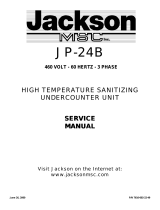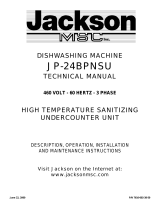
MSC‑1 Installation & Operating Instructions 11
LIMITED WARRANTY AND LIABILITY
Easy Heat warrants that if there are any defects in material or
workmanship in any heating cable or accessory during the first
year after the date of purchase. We will provide new products
to replace any defective items, or we will refund the purchase
price paid for the accessory or cable, not including any labor
or other installation costs. As an alternate, we may elect to
repair the cable or accessory at our factory with all shipping
and other removal costs borne by the purchaser.
We further warrant that for a period of twelve (12) months after
the date of performance any services performed hereunder will
be in a good and skillful manner, based on our understanding
of pertinent technical data as of the date of performance of
such services. Easy Heat’s sole responsibility and liability
in the event of any defect, error, omission, or failure in the
services rendered hereunder shall be to provide corrected
services of the type provided for herein, designed to correct
such defect, error, omissions, or failure, and in no event shall
Easy Heat’s liability with respect to such warranty exceed
the amount received by it from the Buyer on account of such
services.
Our obligation to provide corrected services, new products,
refund the purchase price, or perform the repair described
above is conditioned upon (a) the installation of the accessory
or cable conforming to the specifications set forth in our
installation instructions and (b) the accessory or cable not
having been damaged by mechanical or electrical activities
unrelated to the operation of the accessory or cable.
A refund of your purchase price, provision of replacement
products, repair of the accessory or cable or provision of
corrected services as described above, shall be your sole and
exclusive remedy for a breach of this warranty. THESE ARE
THE SOLE AND EXCLUSIVE WARRANTIES GIVEN BY EASY
HEAT WITH RESPECT TO THE GOODS AND SERVICES AND
ARE IN LIEU OF AND EXCLUDE ALL OTHER WARRANTIES,
EXPRESS OR IMPLIED, ARISING BY OPERATION OF LAW
OR OTHERWISE, INCLUDING WITHOUT LIMITATION,
MERCHANTABILITY AND FITNESS FOR A PARTICULAR
PURPOSE WHETHER OR NOT THE PURPOSE OR USE HAS
BEEN DISCLOSED TO EASY HEAT IN SPECIFICATIONS,
DRAWINGS OR OTHERWISE, AND WHETHER OR NOT
EASY HEAT’S PRODUCTS ARE SPECIFICALLY DESIGNED
AND/OR MANUFACTURED BY EASY HEAT FOR YOUR USE
OR PURPOSE.
This warranty does not extend to any losses or damages due
to misuse, accident, abuse, neglect, normal wear and tear,
negligence, unauthorized modification or alteration, use
beyond rate capacity, or improper installation, maintenance
or application. To the extent that you or your agents have
supplied specifications, information, representation of
operating conditions or other data to Easy Heat in the selection
or design of the Goods and the preparation of Easy Heat’s
quotation, and in the event that actual operating conditions
or other conditions differ from those represented by you, any
warranties or other provisions contained herein which are
affected by such conditions shall be null and void.
If within thirty (30) days after your discovery of any warranty
defects within the warranty period, you notify Easy Heat thereof
in writing, Easy Heat shall, at its option, repair, correct or
replace F.O.B. point of manufacture, or refund the purchase
price for, that portion of the Goods found by Easy Heat to be
defective. Failure by you to give such written notice within
the applicable time period shall be deemed an absolute and
unconditional waiver of your claim for such defects. Goods
repaired or replaced during the warranty period shall be
covered by the foregoing warranty for the remainder of the
original warranty period or ninety (90) days from the date
of shipment of the repaired or replaced goods, whichever is
longer.
This limited warranty does not cover any costs relating to
the repair or replacement of any accessory or cable at the
installation site. Our accessories and cables are not easily
accessible. A failed accessory or cable usually cannot be
easily repaired. Replacement of a failed accessory or cable
will require that the materials under which it is installed be
removed to permit replacement of the accessory or cable.
We will not reimburse any costs relating to the repair or
replacement of any accessory or cable at the installation
site.
IN NO EVENT, REGARDLESS OF THE FORM OF THE CLAIM
OR CAUSE OF ACTION (WHETHER BASED IN CONTRACT,
INFRINGEMENT, NEGLIGENCE, STRICT LIABILITY, OTHER
TORT OR OTHERWISE), SHALL EASY HEAT’S LIABILITY TO
YOU AND/OR YOUR CUSTOMERS EXCEED THE PRICE PAID
BY YOU FOR THE SPECIFIC GOODS PROVIDED BY EASY
HEAT GIVING RISE TO THE CLAIM OR CAUSE OF ACTION.
YOU AGREE THAT WE SHALL NOT BE LIABLE TO YOU OR
YOUR CUSTOMERS FOR ANY INCIDENTAL, SPECIAL OR
CONSEQUENTIAL OR PUNITIVE DAMAGES. No agent,
employee or representative of ours has authority to bind us
to any affirmation, representation or warranty concerning the
goods sold unless such affirmation, representation or warranty
is specifically incorporated by written agreement.
To obtain new products, arrange repair of existing product,
or a refund under this warranty, please contact Easy Heat
with a description of the defect and proof of purchase at the
address noted herein.
DISCLAIMER
All information presented in this document was believed
correct at the time of printing. We reserve the rights to
make any modifications of this document without any prior
notification.
USA
2 Connecticut South Drive
East Granby, CT 06026
Tel. (800) 537-4732
Fax (888) 324-2440
CANADA
99 Union St.
Elmira, Ont. N3B 3L7
Tel. (519) 669-2444
Fax (519) 669-6419















